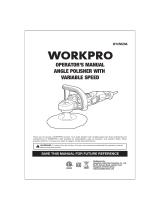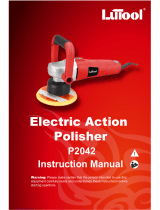
SAFETY INSTRUCTIONS
SPECIFIC SAFETY INSTRUCTIONS
FOR CORDLESS TOOLS
1. Cordless tools get their electrical power from
batteries. They demand the same respect that
corded tools demand. Cordless tools are very
capable of causing injury if all safety
precautions are not followed. Cordless tools
come in many types; read and understand the
section of this booklet for the type of cordless
tool you are using, as well as the operator’s
manual provided with the tool.
2. Cordless tools may create sparks, so do not
use them in an explosive atmosphere, near
ammable liquids, gases or dust.
• To avoid accidental starting, remove batteries
or lock o the switch when the tool is not being
used, when changing accessories, and when
adjusting or cleaning tools.
• Keep hands away from rotating or moving
parts.
• Broken or abused battery packs can leak
chemicals that can cause irritation or burns.
If you come into contact with these chemicals,
ush the area with water. If it contacts the
eyes, ush with water and seek medical help.
3. Batteries may vent gas that can explode near
a source of ignition, like a pilot light. Never use
any cordless tool in the presence of open ame.
Do not place battery packs near re or heat. The
battery packs could explode.
4. Choose the right battery pack for the tool.
Use cordless tools only with their recommended
battery packs. Other battery packs may create a
risk of re, burns, and explosions.
5. Charge battery pack safely.
• Charge battery packs only with their
recommended chargers.
6. Charge in a dry location.
• Do not charge near combustible materials.
• Do not use a charger or battery pack if it has
been hit, dropped or damaged.
• Do not take apart the charger or battery pack.
Take it to an authorized service center for all
repairs.
• Keep tools, battery packs and chargers out of
the reach of children and people unfamiliar with
the tools.
7. Maintain and store battery packs safely.
Clean the contacts on the battery pack and tool
with a pencil eraser if the tool isn’t working at full
power with a fully charged battery pack.
• Take the tool, charger, and battery to an
authorized service center for all repairs. Do not
attempt to repair them yourself.
Store battery packs away from other metal objects
like paper clips, coins, keys, nails, screws,
or other small metal objects. These things can
make a connection from one terminal to the
other, shorting the battery terminals together and
causing burns or re.
Store the battery pack away from extreme
temperature conditions.
8. Disposing of Battery Packs:
Properly dispose of battery packs to help protect
our environment. Battery pack chemistries can
be dangerous to the environment under certain
conditions. Recycle or dispose of properly.
Refer to the instructions included with your battery
pack for proper disposal/recycling of the battery
packs. Local, state, or federal laws may
prohibit disposal of certain batteries in ordinary
trash.
• Place electrical tape over the battery pack’s
terminals before disposing/recycling.
• Do not incinerate a battery pack or throw it into
re even if it is damaged or is completely worn
out. Battery packs can explode in a re.
Use the battery charger correctly
• Refer to the section of this manual relating to
use of the battery charger before attempting to
charge the battery.
• DO NOT attempt to use the charger with any
batteries other than those supplied. Keep your
battery charger clean; foreign objects or dirt may
cause a short or block air vents. Failure to follow
these instructions may cause overheating or re
• If the supply cord is damaged, it must be
replaced by the manufacturer, the service agent
or similarly qualied persons in order to avoid a
hazard
DO NOT attempt to recharge
non-rechargeable batteries.
Page 6


















